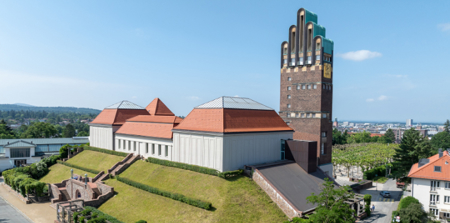

Exhibition Hall Mathildenhöhe
refurbishment
The Mathildenhöhe Darmstadt is a globally unique architectural and urban work of art, which was named a UNESCO World Heritage Site in July 2021. The exhibition building, built in 1908 at the highest point of the city according to the plans of Josef Maria Olbrich, together with the Wedding Tower, which was built at the same time, still characterizes the cityscape today. (www.mathildenhoehe-darmstadt.de). The reason for the renovation was initially the outdated building technology, which no longer met the high conservation requirements for temporary exhibition houses with supra-regional standards. The sustainable, interdisciplinary energy concept was funded by the German Federal Environmental Foundation and takes advantage of the specific framework conditions of the location. For example, the historic water reservoir under the exhibition house will be included in the system technology as an energy storage system. The quality of the outer shell can be significantly improved by a new, very high-performance mineral insulating plaster. Modern glass allows a controlled and efficient use of daylight while minimizing heat losses. In the course of the planning process, the energy-efficient renovation was expanded to include a far-reaching overall renovation of the historic building in accordance with the requirements of the listed building. An intelligent redistribution of the space programme will create space for a new café on the west side facing the plane tree grove, which is now also barrier-free. Between the exhibition building and the wedding tower, a new representative space is made possible by the sensitive dismantling of previous conversions, which in its architectural formulation is clearly recognizable as a component of the 2020s and, together with many other carefully developed details, adds another, present-day layer of time to the iconic building.